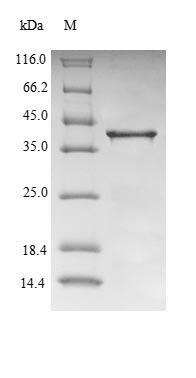Recombinant Mouse Transthyretin (Ttr) is produced in an E. coli expression system and includes amino acids 23 to 147 of the protein. This partial protein carries an N-terminal GST tag, which makes purification and detection in research applications much more straightforward. The purity level appears to exceed 90%, based on SDS-PAGE analysis. Endotoxin levels are kept at a low threshold, which should make it suitable for sensitive experimental setups.
Transthyretin acts as a transport protein that's mainly involved in binding and carrying thyroxine and retinol-binding protein-vitamin A complex. It seems to play a critical role in how thyroid hormone gets distributed and metabolized. This protein has become significant in studies looking at protein folding and stability, plus its misfolding implications in amyloid diseases - potentially offering valuable insights into related biological pathways.
Potential Applications
Note: The applications listed below are based on what we know about this protein's biological functions, published research, and experience from experts in the field. However, we haven't fully tested all of these applications ourselves yet. We'd recommend running some preliminary tests first to make sure they work for your specific research goals.
Mouse Ttr is a tetrameric protein that functions in thyroxine transport and requires precise quaternary structure formation for activity. The E. coli expression system can produce soluble proteins, but the large GST tag (∼26 kDa) may sterically hinder proper tetramerization of the Ttr fragment (23-147aa). Additionally, the partial sequence may lack structural elements needed for native folding. While the protein may be soluble, the probability of correct tetramer formation and functional ligand-binding activity is low.
1. Antibody Development and Validation
This recombinant Ttr fragment serves as an excellent immunogen for generating antibodies against linear epitopes of mouse Ttr. The high purity and defined sequence ensure targeted antibody production. However, antibodies may not efficiently recognize conformational epitopes on native tetrameric Ttr.
2. In Vitro Protein Stability and Aggregation Studies
This is the essential first step to assess the protein's biophysical properties. Techniques like size-exclusion chromatography can determine oligomeric state (likely monomeric due to the tag), while thermal shift assays can evaluate stability. These studies provide critical quality control data for the protein itself, not the native protein.
Final Recommendation & Action Plan
The large GST tag and partial sequence make this recombinant Ttr unsuitable for functional studies requiring a tetrameric structure. Prioritize Application 4 (Stability Studies) to assess the protein's oligomeric state and stability. Application 2 (Antibody Development) can proceed immediately for generating linear epitope antibodies. Ttr's physiological interactions depend on tetrameric structure. A misfolded, monomeric fragment with a large tag is unlikely to replicate native interactions. Functional binding studies (e.g., thyroxine affinity) require properly folded tetrameric Ttr. This misfolded fragment will not bind ligands with native affinity or specificity, making species comparisons invalid.






